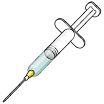Routes of Administration Requiring Sterile Formulations
Some routes of administration demand that products do not bring microbial contamination
with them into the body. This is required because some routes of administration
by-pass the body's natural defense mechanisms, or some tissues or organs are
so sensitive and vital that such contamination could be serious.
All of these "sterility demanding" routes are parenteral routes.
NOTE: But not all parenteral routes are "sterility demanding" routes.
 The term parenteral means next to
or beside the enteral. Enteral refers to the alimentary tract, so parenteral
means sites that are outside of or beside the alimentary tract. Since oral, buccal,
sublingual, and rectal comprise the enteral routes of administration, any other
route is considered a parenteral administration site. Topical administration
is a parenteral route that does not require sterile formulations.
The term parenteral means next to
or beside the enteral. Enteral refers to the alimentary tract, so parenteral
means sites that are outside of or beside the alimentary tract. Since oral, buccal,
sublingual, and rectal comprise the enteral routes of administration, any other
route is considered a parenteral administration site. Topical administration
is a parenteral route that does not require sterile formulations.
The parenteral routes of administration are used for various reasons.
- If a drug is poorly absorbed when orally administered
or is degraded by stomach acid or the gastrointestinal enzymes, then a parenteral
route would be indicated.
- The parenteral routes are also preferred when a rapid
and predictable drug response is desired as in a emergency situation.
- Parenteral routes of administration are also useful
when a patient is uncooperative, unconscious, or unable to take drug via an
enteral route.
- Parenteral routes are used when localized drug therapy is desired.
- They provide a predictable and nearly complete bioavailability.
But there are major disadvantages.
- Most of these parenteral formulations are more expensive
than enteral route formulations.
- Most these parenteral formulations must be sterile.
- Many formulations require that a skilled or trained person administer them.
- Once the drug is administered, it may be difficult to remove the dose is there if an adverse or toxic reaction.